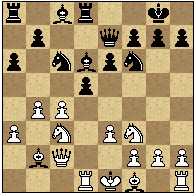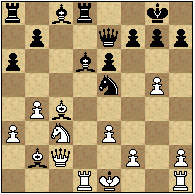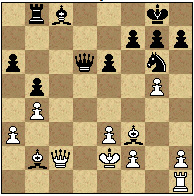Moscow Open 2014 Premier Russian Cup
D. Swiercz – P. Vishnu
1. d4 d5 2. c4 e6 3. Nf3 c5, The Tarrasch Defense is rarely seen these days, although it did serve as the shield of defense against 1. d4 for Spassky and Kasparov in their world championship matches. 4. e3
[Instead of Rubenstein's antidote 4. cxd5 exd5 5. g3, white settles on the symmetrical line of the Tarrasch.]
4... Nf6 5. Nc3 Nc6 6. a3
[White stubbornly refuses to play against an isolated queen pawn (after 6.cxd5 exd5), and demonstrates his willingness to play with one himself (after 6.а3 сxd4 7.exd4).]
6... a6 7. dxc5 Preparing an expanded fianchetto on the queenside (b2-b4), which is a logical continuation of white's sixth move. We note that here the transition to an isolated d5 pawn position with 7.cxd5 exd5! was less accurate, as with the inclusion of а2-а3 and а7-а6 plays into the hand of the side with the isolani. 7... Bxc5 8. b4 Bd6 9. Bb2 O-O 10. Qc2
[A necessary fight for tempo. After 10. Bd3 dxc4 11. Bxc4 b5 12. Bd3 Bb7 13. O-O white has suddenly become black, and with 13... Ne5! Black seizes the initiative.]
10... Qe7
[In case of 10... dxc4 11. Bxc4 b5 12. Bd3 Bb7 white is first to play13. Ne4! In the game Utasi – Klinger, Havana 1986 black, not wishing to concede the initiative, decided on 13... Bxb4!? 14. axb4 (14. Кe2!?) 14... Nxb4 15. Nxf6+ h8 16. Qc3 Nxd3+ 17. Кe2 Nxb2 18. Nh5 f6 19. Qxb2 Qd5 with compensation for the sacrificed piece.]
11. Rd1 Rd8

12. g4!? In modern chess the move g2-g4 in the early stages of the game has become a typical trick in fighting for the initiative. In what openings isn't it found! We may see it in the Slav Defense, in the Sicilian Defense (that goes without saying), the English Opening, Philidor Defense, and Caro-Kann Defense. But in the current position12.g4 had been played back in the game F. Olafson – Sliva, Moscow 1956, and only this once!
[We may add that the usual continuation is 12. Be2 dxc4 13. Bxc4 b5 14. Bd3 Ne5 15. Nxe5 Bxe5 16. f4 Bc3 17. Bxc3 Bb7;
or 12. cxd5 exd5 13. Be2 Be6 Not giving white anything significant.]
12... dxc4 Evaluating g2-g4 depends largely on investigating the continuation 12...Nxg4, so that in answer to 13.cxd5 or 13.Rg1 continue 13...Nсе5 13. g5! This happens to be an innovation. The source game continues 13.Bxс4, and here again the consequences of taking the g4 pawn need to be calculated. 13... Ng4 14. Bxc4 Nge5 15. Nxe5 Nxe5

16. Ne4! Justifying the placement of the pawn on g5 can be done only be acting energetically, therefoer white wastes no time preventing the exchange of the c4 bishop. 16... b5
[To 16... Nxc4 an effective continuation is 17. Nf6+! (black has no problems after 17. Qxc4 e5!) 17... gxf6 18. gxf6 Qc7 19. Rg1+ Кf8 20. Qxh7 Кe8 21. Кe2!! (in case of 21. Rg8+ Кd7 22. Rg7+ Кc6 the black king has fled to safety; and 21. Rg7 called for the counterattack 21... Bxb4+!), and black has no easy time finding a satisfactory defense. For example: 21... Nxb2 (or 21... b5 22. Rg7) 22. Rg8+ Kd7 23. Qxf7+ Кc6 24. Rc1+ Кb6 25. Rxc7 Rxg8 26. Qxg8 Кxc7 27. f7 with a clear advantage for white.]
17. Be2 Ng6
[The development 17... Bb7 is met by the blow 18. Rxd6!]
18. Rxd6 Rxd6 19. Nxd6 Qxd6 20. Bf3 Rb8 21. Кe2

White has come out clearly on top. His bishops control open diagonals, and the major pieces are seizing the central files. 21... Qe7 22. Rc1 Bb7 23. Bxb7 Qxb7 24. Qc7 Qa8 Black avoids the queen exchange, after which he would have nothing to withstand the active intruding pieces. 25. Qc3 e5 26. Qc6 Qa7

In case of 27.h4 black can still manage to consolidate by 27...Qе7. However... 27. Bxe5! This miniature combination decides the outcome of the conflict. 27... Rf8
[27... Rd8 is followed by yet another blow - 28. Bxg7!]
28. Bd6 Rd8 29. Qc8 Qa8 30. Qxa8 Rxa8 31. Rc6 With the exchange of queens the fight is over. Still there continued: 31... f6 32. gxf6 gxf6 33. Bc5 Кf7 34. f4 a5 35. Bd4 axb4 36. Rxf6+ Кe7 37. axb4 Ra2+ 38. Кd3 Ra3+ 39. Кe2 Ra2+ 40. Кf3 Rxh2 41. Rb6 1-0









